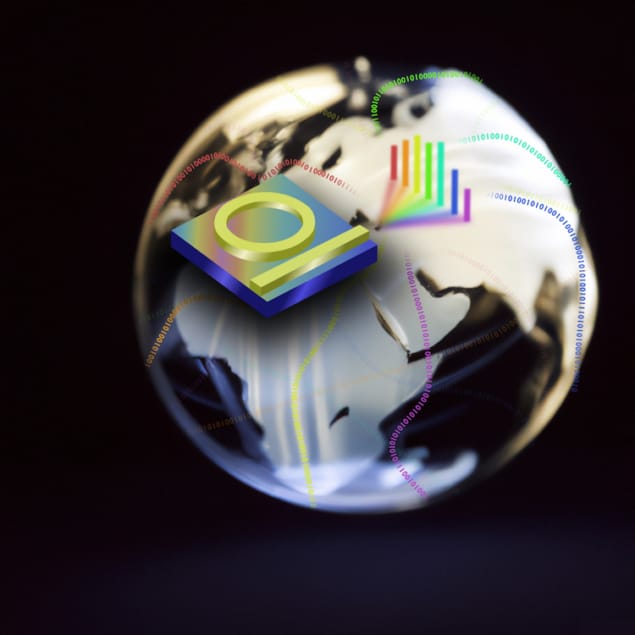Single light source breaks data transmission rate record
08 Dec 2022 Isabelle Dumé
Artist’s impression of the new light source. Courtesy: A Jørgensen
A single light source has transmitted a record-breaking 1.8 petabits of data per second, say researchers in Denmark and Sweden. The achievement could aid the development of highly energy-efficient optical transmitters, thereby reducing the carbon footprint of the Internet and other data-hungry systems.
The record-breaking light source is an optical chip that uses light from a single infrared laser to produce a rainbow spectrum of frequencies – a set-up known as a frequency comb. In the latest study, a team led by Leif Katsuo Oxenløwe at the Technical University of Denmark showed that this chip, which was developed by Victor Torres-Company and colleagues at Chalmers University of Technology in Sweden, has an extraordinary ability to carry data.
To create the frequency comb, Oxenløwe and colleagues injected a single laser beam into a component called a silicon nitride ring resonator. As the resonator oscillates, it outputs a range of new frequencies at discrete intervals. These frequencies form the lines, or teeth, of the comb.
The team then split the power of the comb’s spectrum into 37 parts, directing 1/37th of the total power to each output. After the outputs are amplified using an optical fibre amplifier, the individual frequency lines are separated and modulated to carry data. The data-carrying comb teeth are then merged back together, reamplified to compensate for loss due to modulation, and sent down a “space-division-multiplexed” 37-core fibre. Finally, at the other end of the fibre, the channels are separated and checked to verify the transmission.
Scaling up could lead to 100 Pbits/s transmission
In their experiments, the researchers found that this source transmitted 1.8 petabits (or 1.8 billion gigabits) of data per second. “This is the first time that researchers have investigated just how much data a single frequency comb can carry, when considering feeding it to many parallel channels, such as wavelength and spatial channels,” explains Oxenløwe, physicist and professor of photonic communication technology at TU Denmark’s Centre of Excellence for Silicon Photonics for Optical Communications.
The team’s theoretical analyses indicate that the new record is a floor, not a ceiling. This is because the system is scalable: not only can it create many frequencies, it could also split these frequencies into numerous spatial copies and then optically amplify them, making them into parallel sources for transmitting data.
With more parallel fibres in a cable, or multiple cores in a fibre, Oxenløwe says the technology “should be able to support 100 times more than we experimentally demonstrated – that is 100 Pbit/s if we use a couple of thousand fibres”. He notes that all these frequencies would be coherent with each other, and would have a fixed separation between them, which is very useful for data transmission.
More energy-efficient optical communication transmitters
Cables containing thousands of fibres are already on the market and are commonly used transport large quantities of data around data centres. This makes scaling to such numbers realistic, Oxenløwe says. What is more, all these fibres can be fed with light from a single source, doing away with the thousands of lasers that would otherwise be required to transmit data using current state-of-the-art commercial equipment.READ MORE

“The power and potential of frequency combs is thus far greater than I think most comb-enthusiasts even dared to dream of,” Oxenløwe says. “We may now be able to design more energy-efficient optical communication transmitters.”
Oxenløwe notes that while previous demonstrations have succeeded in transmitting data at rates of up to 10 Pbit/s, this is the first time the essential light needed to carry data all comes from a single chip-based light source. “For future transmitters and receivers in optical communication systems, it will be useful to integrate lasers, resonators, modulators and electronic circuitry on the same chip,” he says, “and finding the best way to do this will be very important.”
The researchers report their work in Nature Photonics.

Isabelle Dumé is a contributing editor to Physics World
from physicsworld.com 12/12/2022

Δεν υπάρχουν σχόλια:
Δημοσίευση σχολίου